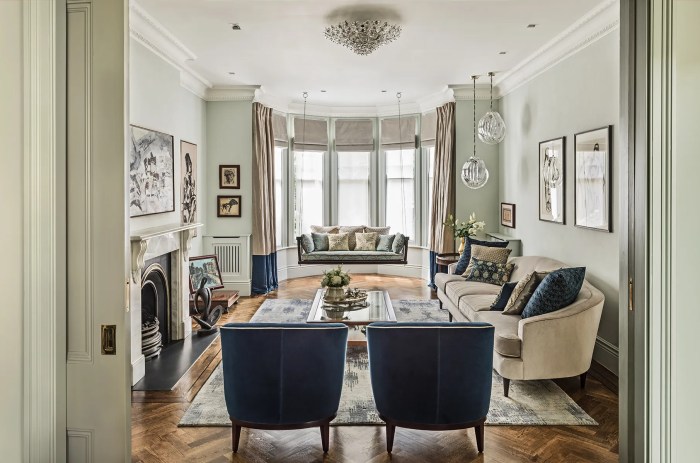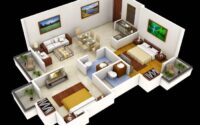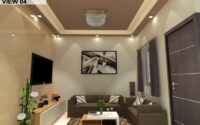British House Interior Design: A Timeless Style
British house interior design has captivated homeowners for centuries, offering a blend of classic elegance and modern sophistication. From the grand estates of the Georgian era to the cozy cottages of the countryside, British interiors exude a timeless charm that reflects the nation’s rich history and cultural heritage.
This exploration delves into the evolution of British interior design, highlighting key periods, styles, and trends that have shaped the way homes are designed and decorated today.
The enduring appeal of British interior design lies in its ability to seamlessly blend traditional elements with contemporary aesthetics. Whether you prefer the grandeur of a stately manor or the simplicity of a modern loft, there’s a British design style to suit every taste.
This guide will explore the defining characteristics of British interiors, from color palettes and furniture choices to the use of materials and textures, offering insights into the principles and practices that make British homes so unique and inviting.
Color Palettes: British House Interior Design

British house interior design draws inspiration from the country’s rich history, diverse landscapes, and enduring cultural influences. This is reflected in the color palettes used, which often evoke a sense of tranquility, sophistication, and timeless elegance.
Traditional Color Palettes
Traditional British interior design embraces a range of colors that have been favored for centuries. These palettes are often inspired by the natural beauty of the British countryside, with earthy tones, deep greens, and muted blues dominating the scene.
- Warm Neutrals:Cream, beige, and soft browns are often used as base colors, creating a sense of warmth and inviting atmosphere. These colors are reminiscent of the mellow tones of stone walls and weathered wood, adding a touch of rustic charm.
- Deep Greens:Inspired by lush gardens and rolling hills, deep greens, such as olive, emerald, and hunter green, are frequently used to add depth and sophistication. These colors can be incorporated through furniture upholstery, wall accents, or even floral patterns.
- Muted Blues:Drawing inspiration from the vast skies and coastal landscapes, muted blues, such as navy, indigo, and sky blue, bring a sense of serenity and calmness to the interior. These colors are often used in accent pieces, curtains, or even as a backdrop for a statement wall.
Contemporary Color Palettes
While traditional palettes remain popular, contemporary British interior design embraces a more modern approach to color. This trend incorporates bold hues, vibrant accents, and a focus on creating a sense of energy and individuality.
- Bold Accents:Contemporary palettes often feature a base of neutral colors, such as white, gray, or black, with pops of vibrant color used to add personality and interest. These accents can range from a bright yellow sofa to a striking red artwork, creating a dynamic and visually appealing space.
- Earthy Tones:Even in contemporary settings, earthy tones continue to play a significant role. However, these colors are often presented in more modern interpretations, such as muted terracotta, deep ochre, or charcoal gray. These colors provide a grounding element and connect the space to the natural world.
- Metallic Finishes:Metallic accents, such as gold, silver, or copper, add a touch of luxury and sophistication to contemporary British interiors. These finishes can be incorporated through furniture hardware, lighting fixtures, or decorative objects, adding a subtle shimmer and visual interest.
British-Inspired Bedroom Color Palette
To create a bedroom that embodies the essence of British interior design, a combination of warm and cool tones is essential. This balance ensures a space that is both inviting and calming, reflecting the traditional charm and modern sensibilities of British style.
- Base Color:A soft cream or light beige can be used as the base color for the walls, creating a neutral backdrop for the remaining elements.
- Warm Accent:A deep terracotta or burnt orange can be introduced through a throw blanket, accent pillows, or a piece of artwork, adding a touch of warmth and inviting energy.
- Cool Accent:A muted blue or gray can be used for the bedding or curtains, adding a sense of tranquility and sophistication.
- Metallic Finish:A gold or silver accent, such as a bedside lamp or decorative mirror, can add a touch of luxury and visual interest.
Furniture and Decor
British interior design is renowned for its timeless elegance and sophisticated charm. From the classic silhouettes of Chesterfield sofas to the intricate details of antique cabinets, British furniture and decor create an atmosphere of warmth and refinement. These elements are not merely decorative but often reflect a rich history and a deep appreciation for craftsmanship.
Distinctive Features of British Furniture
British furniture is known for its enduring quality and meticulous craftsmanship. Some iconic pieces that exemplify this tradition include:
- Chesterfield Sofas:These iconic sofas are characterized by their deep button tufting, rolled arms, and low, wide back. The Chesterfield sofa is a statement piece that adds a touch of grandeur to any room.
- Wingback Chairs:With their tall, winged backrests and padded arms, wingback chairs offer both comfort and style. They are often upholstered in luxurious fabrics like velvet or leather, creating a cozy and inviting atmosphere.
- Antique Cabinets:British antique cabinets, often made of mahogany or oak, showcase intricate carvings, hand-painted details, and elegant hardware. These pieces not only provide storage but also serve as decorative focal points.
Key Decorative Elements in British Homes
Beyond furniture, several decorative elements contribute to the distinctive character of British homes. These include:
- Fireplaces:Fireplaces are a central feature in many British homes, adding warmth and ambiance. They are often adorned with elaborate mantels and surrounded by comfortable seating.
- Wallpaper:Wallpaper is a popular choice for adding pattern and texture to British interiors. From classic floral prints to bold geometric designs, wallpaper can transform a room’s atmosphere.
- Artwork:British homes often feature a curated collection of artwork, ranging from traditional oil paintings to contemporary prints. These pieces reflect the homeowner’s taste and add a personal touch to the space.
British Furniture and Decor Brands
Several British brands are renowned for their exceptional craftsmanship and design in furniture and decor. These include:
- Ercol:Ercol is known for its mid-century modern furniture, characterized by its use of natural materials and simple, elegant lines.
- Heal’s:Heal’s is a long-standing British retailer that offers a wide range of furniture and homewares, from classic to contemporary styles.
- Timothy Oulton:Timothy Oulton specializes in handcrafted furniture with a vintage aesthetic, featuring distressed leather, reclaimed wood, and unique designs.
- Neptune:Neptune is known for its classic and timeless furniture, inspired by English country houses and coastal living.
Materials and Textures
British house interior design is renowned for its elegant and timeless appeal, achieved through a careful selection of materials and textures. Natural elements like wood, stone, and fabrics play a pivotal role in creating a warm and inviting atmosphere.
The Role of Textiles
Textiles are an integral part of British interior design, adding warmth, comfort, and visual interest to any space. From luxurious velvets and silks to cozy wools and linens, a wide array of fabrics are used to create a unique aesthetic.
- Patterns:British interiors often feature classic patterns like florals, paisley, and tartans. These patterns add a touch of traditional elegance and can be incorporated through upholstery, curtains, and rugs.
- Weaves:The texture of fabrics is equally important. Woven textures, such as tweed, herringbone, and damask, add visual interest and depth to upholstery and drapery.
- Textures:The tactile quality of fabrics is also crucial. Soft velvets, textured linens, and chunky knits create a sense of comfort and warmth, inviting you to relax and enjoy the space.
Wood and Stone
Wood and stone are natural materials that bring a sense of permanence and authenticity to British interiors.
- Wood:Oak, mahogany, and walnut are popular choices for furniture, flooring, and paneling. The rich tones and natural grain of these woods add warmth and sophistication to any room.
- Stone:Stone is often used for fireplaces, floors, and countertops. Slate, limestone, and marble bring a sense of grandeur and timeless elegance to British homes.
Material Combinations
The combination of different materials and textures is key to creating a balanced and interesting interior. For example, a luxurious velvet sofa might be paired with a rustic wooden coffee table, or a sleek marble countertop might be complemented by warm wood cabinets.
This interplay of materials adds depth and visual interest to the space.
“The beauty of British interior design lies in its ability to seamlessly blend tradition with modernity, creating spaces that are both elegant and inviting.”
Sustainability and Eco-Friendly Design

The British interior design scene is undergoing a significant shift, embracing sustainability and eco-friendly practices. This trend reflects a growing awareness of environmental concerns and a desire to create homes that are both stylish and responsible.
Sustainable Materials and Practices
Sustainable interior design focuses on using materials and practices that minimize environmental impact.
- Recycled and Upcycled Materials:Incorporating recycled materials like reclaimed wood, repurposed furniture, and upcycled textiles adds character and reduces waste.
- Natural Materials:Opting for natural materials like bamboo, cork, and wool is a sustainable choice. These materials are renewable, biodegradable, and often have low embodied energy.
- Locally Sourced Materials:Choosing materials sourced locally minimizes transportation emissions and supports regional industries.
- Energy-Efficient Appliances and Lighting:Investing in energy-efficient appliances and LED lighting reduces energy consumption and carbon footprint.
- Water-Saving Fixtures:Installing low-flow faucets and showerheads conserves water resources.
Sustainable Kitchen Design
A sustainable kitchen emphasizes environmentally conscious choices in every aspect of design.
- Sustainable Cabinetry:Consider cabinets made from reclaimed wood, bamboo, or certified sustainable wood.
- Eco-Friendly Countertops:Choose countertops made from recycled materials like quartz or concrete, or opt for natural stone like granite or marble.
- Energy-Efficient Appliances:Invest in energy-efficient appliances, such as refrigerators with Energy Star ratings, induction cooktops, and dishwashers with low water consumption.
- Composting and Recycling:Designate a space for composting food scraps and recycling waste to reduce landfill waste.
- Natural Lighting and Ventilation:Maximize natural light by using large windows and skylights. Adequate ventilation is crucial for air quality and energy efficiency.
The Future of British House Interior Design

British house interior design has always been a reflection of the country’s rich history, culture, and evolving lifestyles. As we move forward, several factors will continue to shape the future of British interiors, creating exciting new trends and possibilities.
Technology’s Influence on Interior Design
Technology will play a significant role in shaping the future of British interiors. Smart homes, automation, and interconnected devices will become increasingly integrated into homes. These advancements will influence the design process, with a focus on creating spaces that are functional, efficient, and responsive to individual needs.
For instance, smart lighting systems will allow homeowners to adjust lighting levels and color temperatures based on their preferences and activities, creating a more personalized and comfortable environment.
Sustainable Design Practices, British house interior design
Sustainability will remain a crucial factor in British interior design. Homeowners are becoming increasingly aware of the environmental impact of their choices, leading to a growing demand for eco-friendly materials, sustainable practices, and energy-efficient solutions. Recycled materials, natural fibers, and locally sourced products will be favored.
Evolving Lifestyles and Changing Preferences
The future of British interiors will be shaped by evolving lifestyles and changing homeowner preferences. The rise of remote work and flexible work arrangements has led to a greater emphasis on creating comfortable and functional home offices. Additionally, the growing focus on well-being and mental health will influence interior design choices, with a greater emphasis on creating spaces that promote relaxation, mindfulness, and a sense of calm.
Key Trends and Styles in British House Interior Design
The future of British interior design will see a blend of classic and contemporary styles, with a focus on creating spaces that are both stylish and functional.
- Biophilic Design:Bringing nature indoors will become increasingly popular, with a focus on incorporating natural materials, greenery, and natural light.
- Minimalism:Simple, clean lines, and a focus on functionality will continue to be popular, with a preference for decluttering and creating a sense of spaciousness.
- Sustainable Luxury:The demand for luxury will continue, but with a focus on sustainability. This trend will see the use of high-quality, ethically sourced materials and sustainable design practices.
- Personalized Spaces:Homeowners will seek to create spaces that reflect their individual personalities and lifestyles, with a focus on creating unique and bespoke interiors.
Last Point
As we’ve journeyed through the captivating world of British house interior design, we’ve uncovered a tapestry of styles, trends, and influences that have shaped the way homes are designed and decorated today. From the classic elegance of Georgian and Victorian eras to the modern sophistication of contemporary designs, British interiors offer a timeless appeal that continues to inspire and captivate homeowners worldwide.
Whether you’re seeking to infuse your home with the warmth and charm of traditional British style or embrace the minimalist and functional aesthetics of modern design, the principles and practices explored in this guide provide a valuable resource for creating a space that reflects your unique taste and embodies the enduring legacy of British interior design.
Frequently Asked Questions
What are some common color palettes used in British house interior design?
Traditional British color palettes often feature muted tones like cream, beige, gray, and navy blue, while contemporary schemes incorporate bolder colors like emerald green, deep burgundy, and mustard yellow. These palettes draw inspiration from the British landscape and cultural influences.
What are some iconic British furniture brands and designers?
Some iconic British furniture brands include:
- Ercol: Known for its mid-century modern furniture with a focus on craftsmanship and natural materials.
- Heal’s: A long-standing British retailer offering a wide range of furniture, lighting, and homeware.
- Timothy Oulton: Creates handcrafted luxury furniture with a focus on classic British designs and reclaimed materials.
- The Sofa Workshop: Specializes in bespoke sofas and armchairs, offering a wide range of styles and customization options.
How do I incorporate sustainable elements into a British-inspired kitchen?
To create a sustainable British kitchen, consider using reclaimed wood for countertops and cabinets, opting for energy-efficient appliances, and choosing eco-friendly materials like bamboo and cork for flooring and accents. Incorporate natural light and ventilation to reduce energy consumption.



